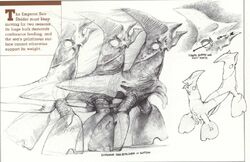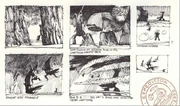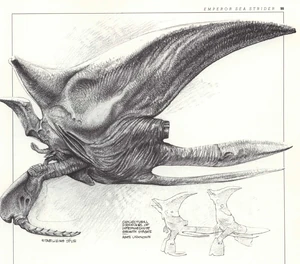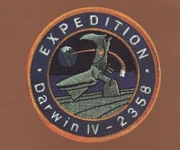
"Virtually no force in Nature could affect such a creature."
The Emperor Sea Strider is an enormous bipedalien from the Amoebic Sea of Darwin IV. It is easily the largest of the planet's creatures. Their young are capable of flight. It was first seen in a Yma faster-than-light satellite image (S.I.848.28) that launched the First Darwinian Expedition of Darwin IV in 2355. They were first thoroughly observed by Barlowe in 2359 near the heart of the Amoebic Sea, a day after his encounter with the sac-backs.
The first sign of these creatures' approach begins with a dull roaring. It is a low noise, which at first seems to be echoing thunder. It is, however, too continuous to be atmospheric. Then there are the rhythmic vibrations, tremors of sorts. These seismic sensations are similar with the huge keeled grove-backs, but these figures indicate an even larger creature.

The emperor sea strider must keep moving for two reasons: its huge bulk demands continuous feeding, and the "sea's" gelatinous surface cannot otherwise support its weight.
The size of this magnificent animal is stunning. It has a great crested head; its sides, heaving with the enormous effort of its walking, can be buffeted by gale-force winds; virtually no force in nature can affect such a creature.
The immense bipedalien's roaring is very loud. It is believed that this sound originates from the two huge "gills" far up the torso in the bony collar. It also has frequent low-range sonar calls, their source being an array of blue-glowing pseudo-arms, which gracefully sway and point. It strides slowly, measuring its vast footfalls, navigating like an ancient ship on some far-off, watery sea.

Emperor sea striders travel in what appear to be mated pairs; they head in the same direction. At times, there can be a sharp whining nearby, similar to the scream of jet engines. It belongs to a flight of small black creatures, faintly bio-lit, heading directly towards the ponderous giants. They careen and bank and, oblivious to gusting winds and lightning that sometimes

The unique feeding feet of the emperor sea strider as they appear from below. Each is rimmed with thousands of razor-sharp teeth. Barlowe was fortunate enough to be presented with this actual view only from a distance.
sweep over the "sea", steer straight into an opening in the front of the sea strider's carapace. They reappear seconds later, having flown through the huge beast's chest and out the fiery exit "gill." The bio-lights on the small flying creatures blaze with renewed energy. Their tails alight with flaming exhaust, the creatures circle almost playfully, leaving behind long gray vapor trails that are twisted into sinuous corkscrews by the wind. There is a distinct similarity between the flyers' crests and those of the sea striders, for the small creatures are the nymph forms of the dark titans they attend. Somehow, as they enter their parents' bodies, they feed upon energy-rich secretions that renew and nourish them. Recent research, which included charting the nymphs' growth to massive adulthood, has proven this theory correct.
The sea striders' oversized feet, which are hollow and contain huge oral tubes, kick up thin mists of minute jelly-shavings. Each oral tube, which leads up through the thighs and into the torso, begins as a mouth on the soles of the feet, where it is rimmed with thousands of sharp teeth. As the beast walks, each sliding footfall shaves off a thin layer of gel, which is quickly sucked up and digested.
It is indicated they are about 190 meters tall, but this estimated accuracy is not entirely certain. They have irregular tiers of lateral breathing flaps, opening and closing with each footfall; gently glowing blue bio-lights accenting the smooth curve of their crests; and swaying tails.

"It looked like some bizarre organic cathedral".
The enormous skull of a sea strider (both the emperor species and lesser species) is riddled with innumerable nerve holes and sutures. It also has a huge and primitive braincase. Something of an enigma, the towering creature’s internal structure seems to become more rigid and lightweight as it approaches its crown with the denser leg muscles and pelvis tissue keeping the center of gravity low.
Amazingly, despite its massive and imposing size, the emperor sea strider can be attacked by skewers on rare occasions. Hunting in pods of up to 30 or more individuals, these predators can overcome even the largest of Darwin IV's inhabitants.
In the case of both emperor and lesser sea striders, young are raised in a unique way. The eggs of these huge creatures are dropped onto the "sea's" undulating surface, where they remain until they hatch. Upon emerging from the eggs, the nymphs must find their way back to their parents until they are fully independent.
Possibly because of the shock absorption and weight distribution qualities of the jellylike "sea," the sea striders have attained truly behemoth proportions. No other known creature rivals them in size.

The awesome, cathedrallike cephalon of the emperor sea strider captured Barlowe's imagination as both architecture and biology. Barlowe found it hard to believe that such a creature could ever walk - until one almost walked over him.

The emperor sea strider in its nymph stage is not yet bipedal. The lower spur-like growths serve as stabilizers in flying; these gradually disappear as the feet develop into massive support and feeding platforms.

The Yma faster-than-light satellite image that launched the first expedition to Darwin IV in 2355.

